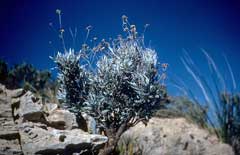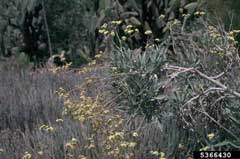 |
|
USDA-NRCS PLANTS Database |
 |
| Howard F. Schwartz, Colorado State University, Bugwood.org |
Translate this page:
Summary
Physical Characteristics

 Parthenium argentatum is an evergreen Shrub growing to 1 m (3ft 3in).
Parthenium argentatum is an evergreen Shrub growing to 1 m (3ft 3in).
See above for USDA hardiness. It is hardy to UK zone 8. It is in leaf all year. The species is hermaphrodite (has both male and female organs) and is pollinated by Insects, wind, Apomictic (reproduce by seeds formed without sexual fusion). The plant is self-fertile.
Suitable for: light (sandy), medium (loamy) and heavy (clay) soils and prefers well-drained soil. Suitable pH: mildly acid, neutral and basic (mildly alkaline) soils and can grow in very alkaline soils.
It cannot grow in the shade. It prefers dry soil and can tolerate drought.
UK Hardiness Map
US Hardiness Map
Synonyms
Plant Habitats
Woodland Garden Sunny Edge; South Wall. By. West Wall. By.
Edible Uses
References More on Edible Uses
Medicinal Uses
Plants For A Future can not take any responsibility for any adverse effects from the use of plants. Always seek advice from a professional before using a plant medicinally.
None known
References More on Medicinal Uses
The Bookshop: Edible Plant Books
Our Latest books on Perennial Plants For Food Forests and Permaculture Gardens in paperback or digital formats.

Edible Tropical Plants
Food Forest Plants for Hotter Conditions: 250+ Plants For Tropical Food Forests & Permaculture Gardens.
More

Edible Temperate Plants
Plants for Your Food Forest: 500 Plants for Temperate Food Forests & Permaculture Gardens.
More

More Books
PFAF have eight books available in paperback and digital formats. Browse the shop for more information.
Shop Now
Other Uses
Latex
A source of rubber obtained by mechanical maceration of the roots and/or stems.[61, 110, 171]. Yields of up to 240 kilos per hectare per year are possible (harvested when plants are 5 years old)[110].
Special Uses
Carbon Farming
References More on Other Uses
Cultivation details
Industrial Crop: Hydrocarbon Management: Coppice Minor Global Crop
Requires a very well-drained soil in full sun[200]. Prefers a sandy soil but cultivated plants succeed on most soils except clay[110]. Established plants are very drought resistant[110]. This species is not very hardy in Britain, plants dislike winter temperatures falling below -10°c and suffer damage below -15°c[11]. In particular, they dislike fluctuating winter temperatures and excessive winter wet[110]. Plants grow well but give a poor yield of latex when growing in areas of higher rainfall[110]. (This refers to the very low levels of rain the plant experiences in its native habitat). More rubber is produced if the plant is prevented from flowering[110]. British summers are possibly not warm enough for this plant to thrive[110].
Carbon Farming
-
Industrial Crop: Hydrocarbon
Materials, chemicals and energy include bioplastics, rubber, biomass products gasoline, jet fuel, diesel, butane, propane, biogas. Plants are usually resprouting plants and saps.
-
Management: Coppice
Cut to the ground repeatedly - resprouting vigorously. Non-destructive management systems maintaining the soil organic carbon.
-
Minor Global Crop
These crops are already grown or traded around the world, but on a smaller scale than the global perennial staple and industrial crops, The annual value of a minor global crop is under $1 billion US. Examples include shea, carob, Brazil nuts and fibers such as ramie and sisal.
References Carbon Farming Information and Carbon Sequestration Information
Temperature Converter
Type a value in the Celsius field to convert the value to Fahrenheit:
Fahrenheit:
The PFAF Bookshop
Plants For A Future have a number of books available in paperback and digital form. Book titles include Edible Plants, Edible Perennials, Edible Trees,Edible Shrubs, Woodland Gardening, and Temperate Food Forest Plants. Our new book is Food Forest Plants For Hotter Conditions (Tropical and Sub-Tropical).
Shop Now
Plant Propagation
Seed - we have no details for this species but suggest sowing the seed in a greenhouse in early spring. Only just cover the seed. When they are large enough to handle, prick the seedlings out into individual pots and grow them on in the greenhouse for at least their first winter. Plant them out into their permanent positions in late spring or early summer, after the last expected frosts.
Other Names
If available other names are mentioned here
Native Range
NORTHERN AMERICA: United States (Texas), Mexico (Chihuahua (east), Coahuila de Zaragoza, Durango (northeast), Nuevo León (south), San Luis Potosí (northwest), Zacatecas, Hidalgo (west))
Weed Potential
Right plant wrong place. We are currently updating this section.
Please note that a plant may be invasive in one area but may not in your area so it's worth checking.
Conservation Status
IUCN Red List of Threatened Plants Status :

Growth: S = slow M = medium F = fast. Soil: L = light (sandy) M = medium H = heavy (clay). pH: A = acid N = neutral B = basic (alkaline). Shade: F = full shade S = semi-shade N = no shade. Moisture: D = dry M = Moist We = wet Wa = water.
Now available:
Food Forest Plants for Mediterranean Conditions
350+ Perennial Plants For Mediterranean and Drier Food Forests and Permaculture Gardens.
[Paperback and eBook]
This is the third in Plants For A Future's series of plant guides for food forests tailored to
specific climate zones. Following volumes on temperate and tropical ecosystems, this book focuses
on species suited to Mediterranean conditions—regions with hot, dry summers and cool, wet winters,
often facing the added challenge of climate change.
Read More
Expert comment
Author
A.Gray.
Botanical References
200
Links / References
For a list of references used on this page please go here
Readers comment